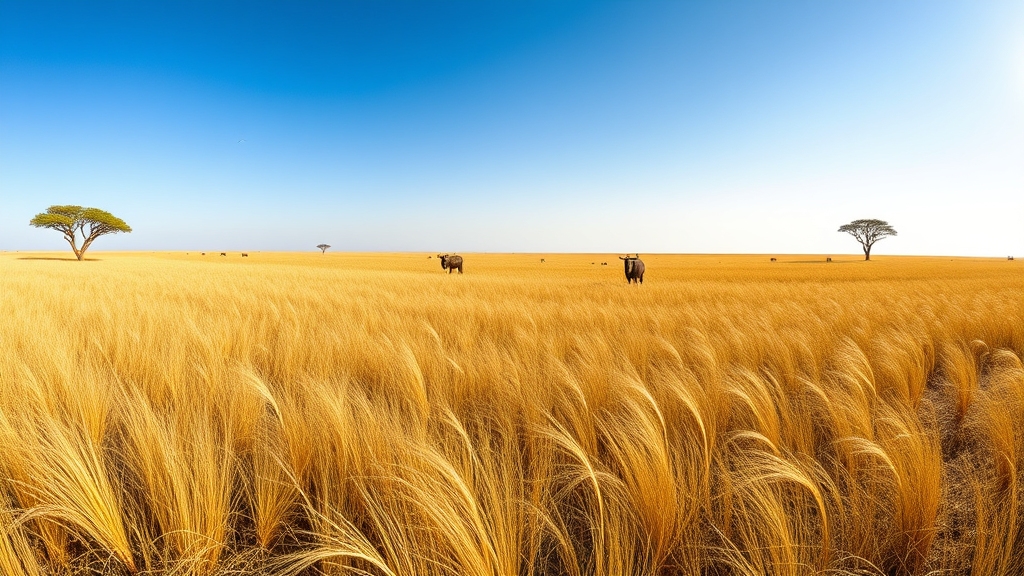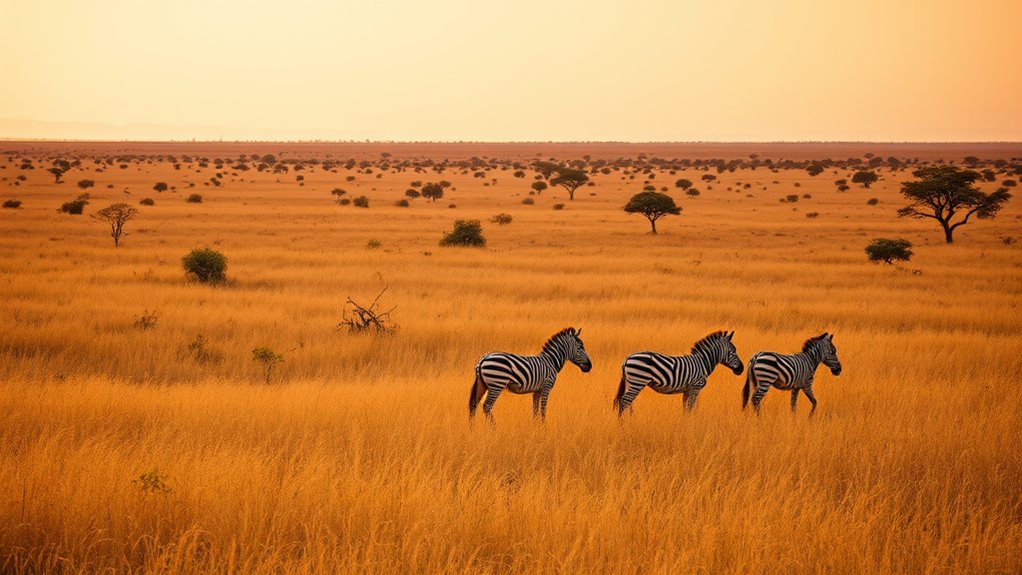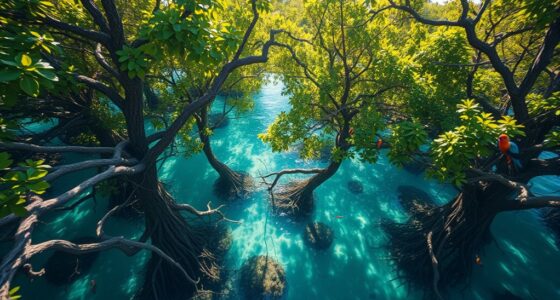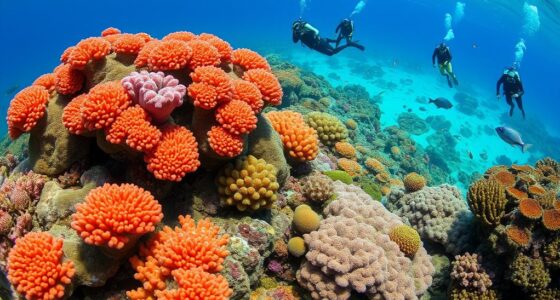Savannas and grasslands cover a large part of Earth’s land and support diverse wildlife, including large mammals, insects, and birds. They’re vital for climate regulation, acting as carbon sinks and shaping ecosystems through natural fire cycles. These landscapes also sustain local communities with resources like food and medicine. Despite their importance, they often go unnoticed. Keep exploring to discover how these ecosystems sustain life and why protecting them matters more than you might think.
Key Takeaways
- Savannas and grasslands cover about one-third of Earth’s land surface, supporting diverse plant and animal life.
- Fire regimes are essential for maintaining the open landscape and preventing woody plant encroachment.
- These ecosystems serve as vital carbon sinks, helping mitigate climate change through soil and vegetation storage.
- They support numerous species, including large mammals, insects, and birds, contributing to rich biodiversity hotspots.
- Despite their importance, savannas and grasslands face threats from agriculture, overgrazing, and climate change, risking ecosystem collapse.

Have you ever wondered what makes savannas and grasslands so essential to our planet? These vast, open landscapes cover about a third of the Earth’s land surface and play crucial roles in maintaining ecological balance. Unlike dense forests, savannas and grasslands are characterized by their grasses, scattered trees, and shrubs, which have evolved unique features to thrive in these often harsh environments. One key adaptation that stands out is fire adaptation. Fires naturally occur here, and plants have developed strategies to survive and even depend on them for regeneration. Many grasses and trees have thick bark, underground storage organs, or the ability to resprout quickly after a burn. Fires prevent the encroachment of woody plants, maintaining the open landscape that supports a diverse array of species. This cyclical process ensures that the ecosystem remains dynamic and resilient, enabling plants and animals to adapt to periodic disturbances. Interestingly, these ecosystems also serve as carbon sinks, helping combat climate change by storing significant amounts of carbon in the soil and vegetation. These fire regimes are vital in shaping the landscape and supporting biodiversity in these regions. Additionally, the soil quality in savannas and grasslands often depends on the recurrent fires that recycle nutrients and maintain fertility, supporting rich plant growth.
Savannas and grasslands depend on fire-adapted plants to sustain their open, resilient ecosystems.
Beyond their resilience, savannas and grasslands are some of the world’s most important biodiversity hotspots. They support a wide variety of species, from towering elephants and sleek predators to tiny insects and vibrant birds. The diverse plant life provides essential food and habitat for these creatures, fostering complex food webs. Many species have evolved specialized behaviors and physical traits to survive in these environments, making them incredibly rich in biodiversity. Protecting these ecosystems is vital because they face threats from agriculture, overgrazing, and climate change. When you understand their importance as biodiversity hotspots, you realize that losing them would mean losing countless species that can’t survive elsewhere.
Furthermore, these ecosystems play a vital role in climate regulation and carbon storage. Their grasses and soil act as carbon sinks, helping to mitigate global warming. Their seasonal rainfall patterns and fire regimes shape the landscape, creating a delicate balance that sustains life here. You can think of savannas and grasslands as natural buffers, supporting livestock, agriculture, and local communities. They also provide essential resources like food, medicine, and raw materials, which are often overlooked in broader discussions about environmental conservation. Notably, the resilience of these ecosystems is partly due to their fire adaptations, which have evolved to thrive in periodic fire events.
In essence, savannas and grasslands are more than just open spaces; they are dynamic, life-supporting systems with intricate adaptations and rich biodiversity. Recognizing their importance and protecting these ecosystems ensures that they continue to perform their essential functions for our planet’s health. When you appreciate their resilience and vital role, you become part of the effort to safeguard these underappreciated yet invaluable landscapes.
Frequently Asked Questions
How Do Savannas Differ From Deserts in Climate and Vegetation?
You’ll notice that savannas and deserts differ mainly in climate variability and vegetation adaptations. Savannas experience seasonal rains, making their climate more variable, while deserts have scarce, unpredictable rainfall. Vegetation in savannas includes grasses and scattered trees adapted to seasonal droughts, unlike desert plants that endure extreme dryness with specialized features like deep roots. This climate variability shapes the distinct vegetation, highlighting their ecological differences.
What Are the Main Threats to Grassland Biodiversity?
Think of grasslands as a fragile web; when threatened, the whole ecosystem suffers. You face main threats like invasive species, which outcompete native plants, and habitat fragmentation, splitting landscapes into isolated patches. These issues diminish biodiversity, endanger native species, and disrupt natural processes. If you ignore these threats, the delicate balance of grassland life could unravel, leading to irreversible loss of these essential ecosystems’ beauty and function.
How Do Fire Regimes Impact Savanna Ecosystems?
You might wonder how fire regimes impact savanna ecosystems. Fire frequency plays a vital role because it influences vegetation adaptation; frequent fires prevent woody plants from dominating, maintaining grassland balance. Conversely, infrequent fires allow shrubs and trees to encroach, altering the habitat. Properly managed fire regimes promote biodiversity and ecosystem health, ensuring that grasses and other plants adapt well to natural fire cycles.
Can Savannas and Grasslands Recover From Overgrazing?
You can help savannas and grasslands recover from overgrazing by implementing effective restoration techniques and grazing management. Restoring native plant species, controlling livestock numbers, and rotating grazing areas allow the ecosystem to regenerate. Proper management prevents soil erosion and encourages biodiversity. With consistent effort and sustainable practices, these ecosystems can bounce back, supporting wildlife and maintaining ecological balance. Your proactive approach makes a real difference in their recovery.
What Roles Do Savannas Play in Global Carbon Cycling?
Imagine balancing Earth’s climate like a tightrope walk—savannas play a vital role. They sequester carbon efficiently, storing it in soil and vegetation, yet also emit methane, a potent greenhouse gas. You might overlook these ecosystems, but they actively influence global carbon cycling, helping mitigate climate change. Their dual role highlights the importance of preserving savannas, ensuring they continue to act as natural climate regulators.
Conclusion
So, next time you stroll through your lush city park, remember you’re missing out on the thrilling, underappreciated drama of savannas and grasslands. These ecosystems quietly support countless species, yet they’re often ignored—perhaps because they lack the flashy glamour of rainforests or coral reefs. But don’t worry, their understated role in the planet’s health keeps the world turning. Who knew that humble grasslands could be so essential, and so tragically overlooked?








